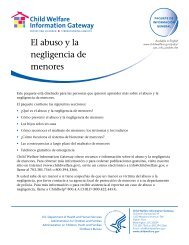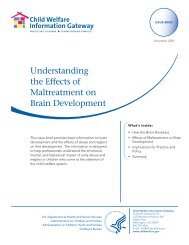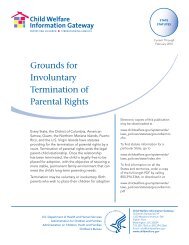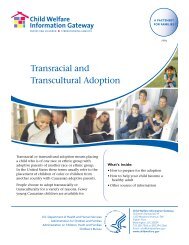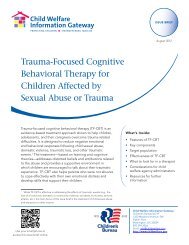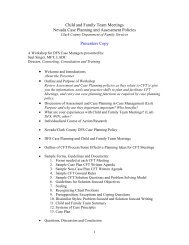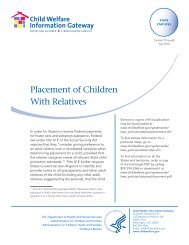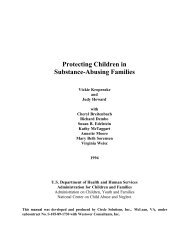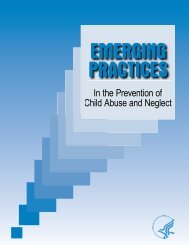Caseload and Workload Management - Child Welfare Information ...
Caseload and Workload Management - Child Welfare Information ...
Caseload and Workload Management - Child Welfare Information ...
Create successful ePaper yourself
Turn your PDF publications into a flip-book with our unique Google optimized e-Paper software.
<strong>Caseload</strong> <strong>and</strong> <strong>Workload</strong> <strong>Management</strong> www.childwelfare.gov<br />
• st<strong>and</strong>ards <strong>and</strong> accreditation. When<br />
developing caseload management<br />
strategies, some States <strong>and</strong> localities take<br />
into consideration the caseload st<strong>and</strong>ards<br />
<strong>and</strong> guidance recommended by CWLA;<br />
others strive to meet the Council on<br />
Accreditation (COA) st<strong>and</strong>ards in order<br />
to achieve accreditation. States have<br />
had varying success in achieving <strong>and</strong><br />
maintaining these st<strong>and</strong>ards.<br />
• systems reform. Currently, some States<br />
are engaged in developing new practice<br />
models <strong>and</strong> implementing systemwide<br />
reform efforts, such as differential response,<br />
family engagement, <strong>and</strong> system of care<br />
initiatives. While caseload/workload<br />
reduction may not be a stated goal of these<br />
reform efforts, it sometimes is a necessary<br />
component or a resultant outcome.<br />
• Union negotiations. Unions representing<br />
child welfare workers have played an<br />
important role in negotiating improved<br />
caseload ratios.<br />
The process of caseload <strong>and</strong> workload<br />
management often begins with workload<br />
<strong>and</strong> time studies. These studies analyze how<br />
work is being done <strong>and</strong> how time is spent,<br />
<strong>and</strong> frequently compare the actual data with<br />
estimations of what is needed to deliver<br />
quality services <strong>and</strong> best practices. <strong>Workload</strong><br />
studies can provide a foundation for:<br />
•<br />
<strong>Workload</strong> studies<br />
<strong>and</strong> Other Tools<br />
Determining how many workers are needed<br />
to h<strong>and</strong>le cases effectively in different<br />
This material may be freely reproduced <strong>and</strong> distributed. However, when doing so, please credit <strong>Child</strong> <strong>Welfare</strong><br />
<strong>Information</strong> Gateway. Available online at www.childwelfare.gov/pubs/case_work_management/<br />
program areas <strong>and</strong> then setting caseload<br />
st<strong>and</strong>ards <strong>and</strong> staff allocations accordingly<br />
• Underst<strong>and</strong>ing how much time workers<br />
spend on providing services to clients,<br />
documenting their work, completing other<br />
administrative tasks, traveling, etc., <strong>and</strong><br />
then identifying more efficient processes<br />
<strong>and</strong> practices<br />
• Exploring how various case characteristics<br />
(such as risk levels, number of siblings,<br />
immigrant status) can influence workload<br />
<strong>and</strong> assessing workflow implications<br />
(Tooman & Fluke, 2002)<br />
• Managing work expectations, which can<br />
lead to higher work satisfaction <strong>and</strong> boost<br />
staff morale (Edwards & Reynolds, 2008)<br />
• Justifying resource allocations <strong>and</strong> building<br />
stakeholder support for caseload/workload<br />
management strategies<br />
Often working with expert consultants,<br />
many States <strong>and</strong> counties across the country<br />
have conducted workload studies using<br />
various methodologies to address their<br />
workforce issues. Several States are now<br />
moving from point-in-time studies to periodic<br />
<strong>and</strong> automated tracking of workloads <strong>and</strong><br />
caseloads to inform ongoing workforce<br />
decisions. Analytic tools, like those used in<br />
Minnesota <strong>and</strong> New Jersey, serve as further<br />
supports to routinely assess caseload data <strong>and</strong><br />
their implications for staffing <strong>and</strong> workflow<br />
management.<br />
In other States <strong>and</strong> counties, however, it has<br />
not been feasible for cost, time, or other<br />
reasons to conduct workload studies. These<br />
jurisdictions can still improve their workforce<br />
management by learning from other workload<br />
study findings to approximate their staffing<br />
4




